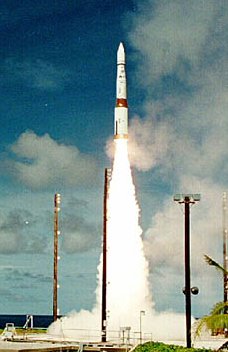The United States launched a ballistic missile at its West Coast yesterday, part of a simulated attack by the Iranian military on California. The test of missile defense against the attack failed.
 Officials say the problem lies in the Sea-Based X-band radar, a Raytheon built radar that is the backbone of America’s defense against missile attacks. The radar “did not perform as expected” and the interceptor missile, which officials insist worked properly, was unable to stop the simulated attack.
Officials say the problem lies in the Sea-Based X-band radar, a Raytheon built radar that is the backbone of America’s defense against missile attacks. The radar “did not perform as expected” and the interceptor missile, which officials insist worked properly, was unable to stop the simulated attack.
It had been expected that the “Iranian” attack would be more difficult than previous simulated attacks from North Korea, due to the angle the incoming missile comes in on. They are still investigating exactly why the radar failed during the $150 million simulation.
Fortunately for those living on the West Coast, Iran’s cream of the crop Shahaab-3 missile has a maximum range of about 1,200 miles. The distance from Tehran to the West Coast of the United States is approximately 7,500 miles, meaning the threat is illusory, though the funding for the failed defense is very real.





What a colossal waste of money! Between the military industrial congressional complex, the banksters, and the US government's policy of perpetual war we are all being sucked dry by a trio of bloated leaches.
Indeed, the USA is a mentally ill country.
As opposed to the enlightened leadership you come from? Go ahead and pretend you are somebody.
Are people supposed to say nothing? Rather than getting angry at somebody just because he shows American hypocrisy, you should call your Congress representative and press him on such aberrant practices. Do you think this monumental waste of money is correct, appropriate and decent in view of the millions of jobless Americans? What does this show anyway? An absolute lack of respect for the hard working ordinary person in the US. But, of course, you still worry about saving face.
"Between the military industrial congressional complex, the banksters, and the US government's policy of perpetual war we are all being sucked dry by a trio of bloated leaches."
Yeah…but doncha know, we gotta freeze "non-security" discretionary spending.
I do not favor a spending freeze. I think all government programs need to be cut substansially or eliminated outright. Before cutting or eliminating any domestic programs, however, I think ALL the troops need to come home, all foriegn military bases need to be closed, all foriegn aid need to be eliminated, and military spending has to be cut down to a reasonable level. A military budget about 15 to 20 billion a year would be a reasonable military budget for DEFENSIVE purposes given the secure geographic position of the United States and the lack of any significant global threat facing the United States. Russia and China have zero interest in invading the United States. Once that task is completed, then it would be time to eliminate Social Securtiy, Medicare, Medicaide and all other programs and departments associated with the welfare/regulatory state.
Agreed.
Truly pathetic propaganda crap this test is….. to pretend you're preparing for threat that quite simply doesn't exist.
foookkk this jooo owned antiwar
Why not cal them Fake Israeli Missile or Fake French Missile? those guys actually have missiles and the nukes to go with them.
How can we be in a depression when we have 150 million dollars to waste on war games?
We always have unlimited funds when it comes to war.
It never costs too much to go to war.
I'm sick to my stomach writing this.
Try to imagine Canada having an "Iranian" fake misile test for British Columbia or Mexico having one for Baja. America is truly insane.
These anti-missile, star-wars tests have been going on since Reagan. This innovation — calling it an "Iranian missile attack" Is just a transparent, brazen, and pitifully obvious propaganda stunt. No better way to insure continued funding, and make your polkitical backers happy, than to slam the bogieman of the moment. Breathtaking crap.
EPIC FAIL!
maybe the one thing that is stopping us from going to war is the ineptitude of the military.
x-band radar = 900 million dollars
missiles = 1 million dollars
weekend war games = 150 million dollars
seeing the look on the generals faces when it failed = priceless!